Osteochondrosis and other lesions in all intervertebral, articular process and rib joints from occiput to sacrum in pigs with poor back conformation, and relationship to juvenile kyphosis
- PMID: 35042517
- PMCID: PMC8764802
- DOI: 10.1186/s12917-021-03091-6
Osteochondrosis and other lesions in all intervertebral, articular process and rib joints from occiput to sacrum in pigs with poor back conformation, and relationship to juvenile kyphosis
Abstract
Background: Computed tomography (CT) is used to evaluate body composition and limb osteochondrosis in selection of breeding boars. Pigs also develop heritably predisposed abnormal curvature of the spine including juvenile kyphosis. It has been suggested that osteochondrosis-like changes cause vertebral wedging and kyphosis, both of which are identifiable by CT. The aim of the current study was to examine the spine from occiput to sacrum to map changes and evaluate relationships, especially whether osteochondrosis caused juvenile kyphosis, in which case CT could be used in selection against it. Whole-body CT scans were collected retrospectively from 37 Landrace or Duroc boars with poor back conformation scores. Spine curvature and vertebral shape were evaluated, and all inter-vertebral, articular process and rib joints from the occiput to the sacrum were assessed for osteochondrosis and other lesions.
Results: Twenty-seven of the 37 (73%) pigs had normal spine curvature, whereas 10/37 (27%) pigs had abnormal curvature and all of them had wedge vertebrae. The 37 pigs had 875 focal lesions in articular process and rib joints, 98.5% of which represented stages of osteochondrosis. Five of the 37 pigs had focal lesions in other parts of vertebrae, mainly consisting of vertebral body osteochondrosis. The 10 pigs with abnormal curvature had 21 wedge vertebrae, comprising 10 vertebrae without focal lesions, six ventral wedge vertebrae with ventral osteochondrosis lesions and five dorsal wedge vertebrae with lesions in the neuro-central synchondrosis, articular process or rib joints.
Conclusions: Computed tomography was suited for identification of wedge vertebrae, and kyphosis was due to ventral wedge vertebrae compatible with heritably predisposed vertebral body osteochondrosis. Articular process and rib joint osteochondrosis may represent incidental findings in wedge vertebrae. The role of the neuro-central synchondrosis in the pathogenesis of vertebral wedging warrants further investigation.
Keywords: Helical computed tomography; Juvenile (Scheuermann’s) kyphosis; Neuro-central synchondrosis; Osteochondrosis; Swine; Vascular failure; Wedge vertebra; Zygapophyseal joint.
© 2022. The Author(s).
Conflict of interest statement
The authors declare that they have no competing interests.
Figures
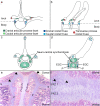

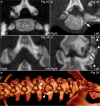
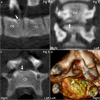
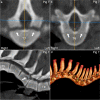

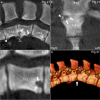
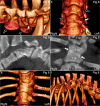
References
-
- Nielsen LW, Hogedal P, Arnbjerg J, Jensen HE. Juvenile kyphosis in pigs. A spontaneous model of Scheuermann's kyphosis. APMIS. 2005;113(10):702–707. - PubMed
-
- Lahrmann KH, Hartung K. Causes of kyphotic and lordotic curvature of the spine with cuneiform vertebral deformation in swine. Berl Munch Tierarztl Wochenschr. 1993;106(4):127–132. - PubMed
-
- Straw B, Bates R, May G. Anartomical abnormalities in a group of finishing pigs: prevalence and pig performance. J Swine Health Prod. 2009;17(1):28–31.
-
- Corradi A, Alborali L, Passeri B, Salvini F, De Angelis E, Martelli P, et al. Acquired hemivertebrae in «humpy-backed» piglets. In: 18th IPVS Congress: 2004. Hamburg: International Pig Veterinary Society; 2004. p. 357.
MeSH terms
LinkOut - more resources
Full Text Sources

